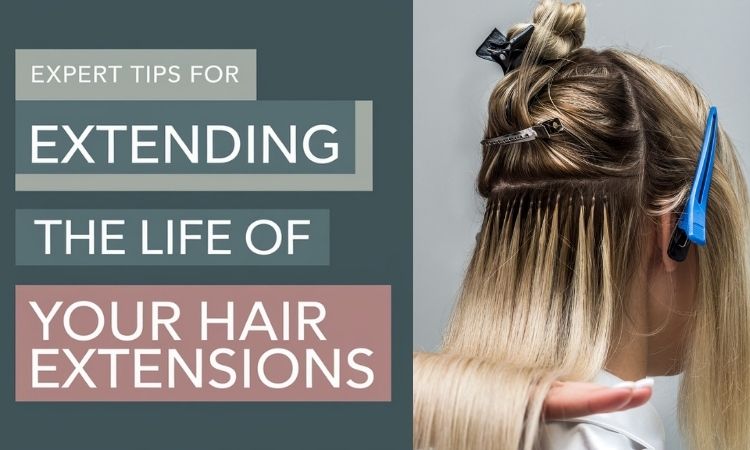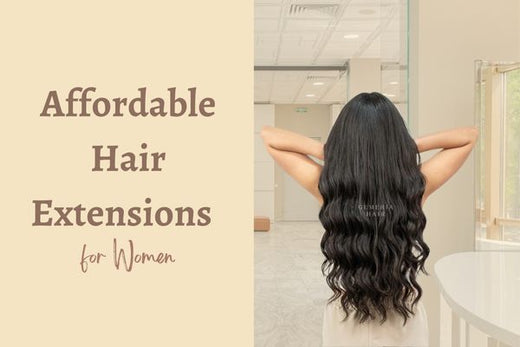Hair extensions are much like a genie if you care for hair extensions properly (there’s no lamp involved, however!)
But why are we calling them so? What wishes are they granting?
Let’s say if you want to add some length or volume to your natural hair or bring a pop of colors to it instantly, hair extensions can whip good magic and help you achieve the look.
More easily accessible than ever—thanks to online shops—people have been increasingly turning to these extensions for quick hair transformations. Add to it, the diversity that’s available in their type, texture, and size. You can choose exactly what you want!
But yes, you can not be caught lacking to maintain hair extensions. Improper handling can lead to loss of shine and breakage within a few weeks, eventually diminishing their lifespan. On the other hand, if you care for hair extensions the correct way, they can last six months or more.

In today’s guide, we’ll learn all about protecting hair extensions—how to maintain their different types, daily tips and specific routines to follow.
Why do you need to care for hair extensions properly?
- To extend lifespan of hair extensions: Regular detangling, gentle washing, and suitable storage prevent damage and ensure your extensions stay durable. Proper care for hair extensions can help avoid premature replacement costs and save you from a ton of frustration.
- To protect shine, softness, and natural look: Without proper care, your extensions may become dry, tangled, or discolored—losing their “natural-ness.” This is especially true for human hair extensions, when faced with environmental conditions like humidity, pollution, and excessive heat styling.
- To save money in the long run: Now, hair extensions are a cosmetic investment. Properly maintaining hair extensions can save you from replacing them frequently, which can drain your pockets.
How to care for different types of human hair extensions?
1. Clip-in extensions

Clip-ins extensions are popular for their ease of use. But they still need regular care, such as:
- Detangle gently: Use a wide-tooth comb to remove knots before storing them. This doesn’t allow tangles to set in while the extensions are not in use.
- Clean them every 10-15 wears: Use sulfate-free shampoo. Exercise caution with the amount of shampoo you use, as too much can weigh the hair down.
- Store them in a breathable bag: This helps avoid dust accumulation and tangling. Check for the clips—they must not be pressed together when stored, as this could cause damage.
2. Tape-in extensions

Tape-ins are semi-permanent solutions and necessarily require professional touch-ups.
- Use sulfate-free shampoo (similar to what we did for clip-ins): But don’t give yourself to scrubbing the adhesive bonds as this weakens the adhesive, causing them to fall out.
- Steer clear of oil-based products: These can erode the adhesive. Be mindful when you apply hair serums or oils near the roots to preserve the gluey bonds.
- Visit your stylist every 6-8 weeks for reapplication: Tape-in extensions need to be repositioned as your natural hair grows out.
3. Sew-in or weave extensions

Sew-ins are durable, but they too need consistent care, including:
- Keep your scalp clean: Also make sure you moisturise the scalp to prevent itchiness and flakiness. Frequent scalp massages with argan oil or and coconut oil can improve circulation.
- Dry completely: After washing your braids and extensions—dry them thoroughly to avoid mildew.
- Visit your stylist regularly: For maintenance, you must visit your stylist once every 6-8 weeks. This can be to adjust the extensions or re-sew any loose threads.
Also Read: Are Your Hair Extensions Healthy?
Synthetic v/s Human hair extensions
Synthetic extensions
- Require minimal care, but can’t handle heat styling.
- Never expose them to high heat or direct sunlight, as synthetic hair can melt or lose its shape.
- Clean them with cool water and synthetic hair shampoo.
Human hair extensions
- Need hydration and can be styled like natural hair (with the help of heat tools).
- Use leave-in conditioners.
- Avoid harsh chemicals (or heavy formulations).
- Trim them regularly to keep the ends healthy.
Also Read: Why Choose Human Hair Extensions Over Synthetic?
Cleaning hair extensions: Step-by-step mini guide
- Before washing, detangling is a must: Use a wide-tooth comb or extension brush to get rid of knots. Start with dry hair to dodge the messy tangling that happens during washing.
- Go for sulphate-free shampoos: They prevent stirpping of moisture and don’t cause any damage to the extensions. Look for products specifically designed for extensions as they help maintain their integrity.
- Wash gently, no brute force: Wet the extensions with lukewarm water and apply shampoo along the length. You should scrub or twist, but massage gently to conserve the natural flow of the hair strands.
- Conditioning too is important: For human hair extensions, apply a hydrating conditioner—focussing on their mid-lengths and edges for full coverage.
- At last, air dry them: Lay the extensions flat on a clean towel and let them air dry naturally. Refrain from using blow dryers, as heat can deplete the hair fibers. If you must, use the blow dryer on a cool setting.
Storing hair extensions: How to do it properly?
Clip-in extensions
- Technique: Detangle the hair. Stack the wefts neatly and clip them together, starting from the smallest to the largest—so that they always stay organized.
- Place of storage: Store the clip-ins in a breathable fabric bag or hang them on a dedicated extension hanger. Ensure that you then keep the bag or hanger in a dust-free area, like a wardrobe or closet.
Also Read: 5 Tips To Secure Your Clip-In Hair Extensions
Tape-in extensions
- Technique: Clean off any adhesive residue from the tape tabs. Actively check for the extensions to be completely dry before storage. All that is left for you to do is lay the tape-ins flat to eliminate bending or creasing.
- Place of storage: You can use a resealable plastic bag or a flat, airtight container to keep the extensions safe. Remember to shift them to a place that is cool, dry and away from sunlight or moisture.
Sew-in extensions or weaves
- Technique: Wash and deep condition the extensions thoroughly before storing to remove any buildup or residue. Once dry, braid or twist them (loosely) into a manageable shape to prevent tangling.
- Place of storage: Store the sew-in extensions in a satin or silk pouch to maintain moisture and prevent frizz. You then transfer the pouch to a cool, dry drawer or closet.
If you’ve been going up and beyond to buy hair extensions online and still end up finding nothing worthwhile, let GEMERIA HAIR be your guide from now on. We’ve in store a broad range of 100% authentic human hair extensions—diverse in shape, size, and texture. So ladies, get a move on and visit us today.
Styling tips to maintain hair extensions
Use low-heat tools to minimize damage.
- Curling wands or flat irons with adjustable heat settings are some of your best allies when it comes to styling human hair extensions.
- Keep the temperature below 180°C (or 350°F) to avoid heat damage.
- Heat protectant sprays can be used as a shield against high temperatures (during super-sunny days).
Tight hairstyles aren’t too healthy for extensions.
- Styles like tight ponytails or braids can strain the roots and dawdle the bonds of your extensions.
- Opt for loose, comfortable updos instead.
- If you must wear tight hairstyles, see to it that the extensions are not left in that state for too long. Release the pressure after a few hours.
Also Read: Best Birthday Hairstyle Ideas for 2025
Always choose gentle products.
- Select styling gels, sprays, or mousses specifically designed for use with extensions.
- Avoid alcohol-based products as they can dry out the hair and cause it to become brittle over time.
Common mistakes that you make
- Overwashing: Washing hair extensions too frequently erases their natural and added moisture—leading them to attain a dry and brittle texture. That’s why we recommend sticking to the washing schedule instructions given with the product, elaborating their unique type and frequency of use.
- Skipping regular brushing: Overlooking the daily “brush your extensions” routine can cause tangling and matting. Use a specialized extension brush to prevent the physical straining of hair strands. Try brushing in sections—it’s a smart move that cuts unnecessary dress on the fibers.
- Improper removal: If you’re currently using permanent hair extensions (like tape-ins or sew-ins), taking professional help for removing them is, without a doubt, not only essential but also the safest process to take them off. Playing about the removal process at home all by yourself can result in breakage and damage to your natural hair.
Conclusion
“How to care for hair extensions?” This could be a daunting trip and pretty exhaustive too, if you don’t know what steps to follow for each type. All you need is a little exploring and experimenting, and a mini-pie of patience along the way.
Begin with developing a consistent care routine that includes proper cleaning, careful storage, gentle styling, and seeking professional help when necessary. Remember, clean extensions retain their shine for a longer time, stored extensions remain tangle-free, while tenderly pleasant styling allows extensions to keep looking natural.
If you have any personal tips or experiences to share, drop them in the comments below. We can always learn from one and another on how to better nurture and protect our gorgeous locks.














